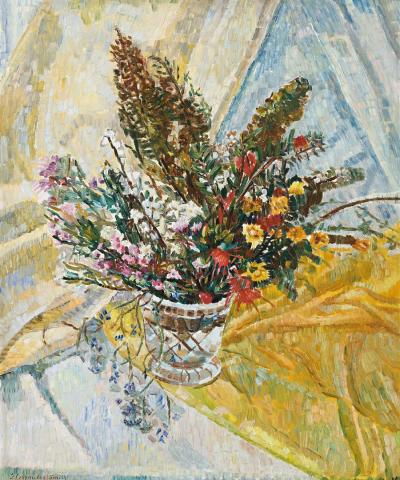WILDFLOWERS IN A GLASS, c.1943
Grace Cossington Smith
oil on pulpboard
61.0 x 50.5 cm
signed lower left: G Cossington Smith
signed and inscribed verso: ‘Wildflowers in a Glass’ / Grace Cossington Smith
Mrs J.H. Coles, Sydney
Private collection, Sydney
Deutscher~Menzies, Melbourne, 28 August 2002, lot 52
Private collection, New South Wales
The Contemporary Group, Blaxland Galleries, Sydney, 3 July – 14 July 1944
Grace Cossington Smith, Art Gallery of New South Wales, Sydney, 1973, cat. 51 (label attached verso)
Thomas, D., Grace Cossington Smith, Art Gallery of New South Wales, Sydney, 1973, cat. 51, p. 43 (illus.)
Wildflowers in a Jug, 1936, oil on board, 63.5 x 51.0 cm, in Thomas, D., 'Grace Cossington Smith', Art and Australia, March 1967, vol. 4, no. 4, p. 309 (illus.), collection of the Art Gallery of New South Wales
Grace Cossington Smith, along with Roy de Maistre and Roland Wakelin, was one of the pioneers of Post Impressionism in Australia, although the subjects of her paintings are anything but avant-garde. Chiefly drawn from her home and house gardens at Turramurra in Sydney's northern suburbs, she found initial inspiration in the familiar. The paintings, however, are anything but ordinary. Shimmering with light, colour, and beauty, she painted works that transcended the everyday to touch upon the infinite - as William Blake wrote, 'To see a World in a grain of sand, And a Heaven in a wild flower.'1
In 1973, Daniel Thomas, then curator at the Art Gallery of New South Wales, wrote in the catalogue to the Grace Cossington Smith retrospective exhibition that 'all her paintings are devotional. They praise God for the glorious things He has created...'2 Few, as the Bible acknowledges, are as beautiful as flowers.
Many of the European flowers in Cossington Smith's still life paintings, such as in Camellia in Jug, c.1926, came from her garden, others were painted in the garden, as in Christmas Lilies Growing, c1927-28, in the collection of the Tasmanian Museum and Art Gallery, Hobart. Spring wildflowers grew further a field, in the nearby bush or were gathered from Lovers Leap gully, as in the distinguished Wildflowers in Jug 1936, presented to the Art Gallery of New South Wales in 1940 by a group of twenty admirers of the artist's work. The choice is significant for the painting is similar to our painting, Wildflowers in a Glass, c.1943, and another fine still life, Blossom with Jug, c.1944-45, once in the collection of Mervyn Horton, first editor of Art and Australia. All share an interest in native flowers and a directness of presentation. Although described as 'still' life paintings, they are anything but that. Flowers set in their vase or jug are placed within a seemingly simple field of drapery of various colours - yet all is bursting with life. The vitality of the brush strokes and the radiance of the colours continue through the swirling movement of the drapery, the actual motif being the centrepiece of this intense activity. Yet, there is an inner serenity, a still moment of meditative perception achieved through the dazzling light captured in the mosaic-like touches of colour. Wildflowers in a Glass was shown with the Contemporary Group, Sydney in 1944, and included in Cossington Smith's grand retrospective exhibition arranged by the Art Gallery of New South Wales in 1973.
1. Blake, W., Auguries of Innocence, c.1803
2. Thomas, D., op. cit., p. 8
DAVID THOMAS
